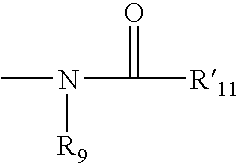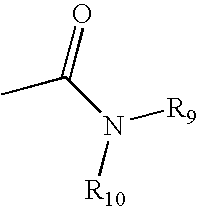Catalyst asymmetric desymmetrization of prochiral compounds
- Summary
- Abstract
- Description
- Claims
- Application Information
AI Technical Summary
Benefits of technology
Problems solved by technology
Method used
Image
Examples
example 1
REFERENCES AND NOTES FOR EXAMPLE 1
[0119] 1. Toyota, M.; Yokota, M.; Ihara, M. Organic Lett. 1999, 1, 1627-1629.
[0120] 2. Couche, E.; Deschatrettes, R.; Poumellec, K.; Bortolussi, M.; Mandvile, G.; Bloch, R. Synlett. 1999, 87-88.
[0121] 3. Paterson, I.; Cowden, C. J.; Woodrow, M. D. Tetrahedron Lett. 1998, 39, 6037-6040.
[0122] 4. a) Borzilleri, R. B.; Weinreb, S. M. J. Am. Chem. Soc. 1994, 116, 9789-9790. b) Borzilleri, R. B.; Weinreb, S. M.; Parvez, M. J. Am. Chem. Soc. 1995, 117, 10905-10913.
[0123] 5. Marie, F. B. C.; Mackiewicz, P.; Roul, J. M.; Buendia, J. Tetrahedron Lett. 1992, 33, 4889-4892.
[0124] 6. a) Ohtani, M.; Matsuura, T.; Watanabe, F.; Narisada, M. J. Org. Chem. 1991, 56, 4120-4123. b) Ohtani, M.; Matsuura, T.; Watanabe, F.; Narisada, M. J. Org. Chem. 1991, 56, 2122-2127.
[0125] 7. Wender, P. A.; Singh, S. K. Tetrahedron Lett . 1990, 31, 2517-1520.
[0126] 8. Suzuki, T.; Tomino, A.; Matsuda, Y.; Unno, K.; Kametani, T. Heterocycles, 1980, 14, 1735-1738.
[0127] 9. a) Heathcock...
example 2
[0137] General Method for Synthesizing Tertiary Amine Catalysts 13
[0138] To a solution of diamine 1 (1.40 g, 4.67 mmol) in dry tetrahydrofuran (93 mL) under nitrogen at room temperature was added sodium hydride (60% suspension in mineral oil, 1.87 g, 46.7 mmol). The mixture was stirred for 10 minutes, and then glycidol nosylate 2 was added. After being stirred for 88 hours, the mixture was filtered, and the filtrate was concentrated under reduced pressure. The resulting residue was purified by chromatography [basic aluminum oxide, CH.sub.3OH:CH.sub.2Cl.sub.2 (1:100 to 1:20)] to give the chiral tertiary amine 3 (667 mg, 35%) as a white solid.
example 3
[0139] Catalytic Desymmetrization of a Meso Bicyclic Succinic Anhydride Comprising a Urea 14
[0140] To a mixture of anhydride (16.8 mg, 0.05 mmol) and DHQD-PHN (20 mol %, 5 mg) in Et.sub.2O (2.5 mL) at -40.degree. C., anhydrous MeOH (0.5 mmol, 20.2 ul) cooled at -20.degree. C. was added in one portion. The resulting mixture was stirred until the reaction was complete (.about.30 hrs) as monitored by TLC (20% MeOH in CH.sub.2Cl.sub.2). The reaction was quenched with aqueous HCl (1 N, 3 mL). The aqueous layer was extracted with EtOAc (2.times.10 mL). The combined organic layer was dried over MgSO.sub.4 and concentrated. The residue was purified by flash chromatography (100% CH.sub.2Cl.sub.2 to 10% MeOH in CH.sub.2Cl.sub.2) to afford the hemiester (16.7 mg, 91% yield). The ee of the hemiester was determined to be 93% by converting the hemiester into the corresponding ester amide (J. Chem. Soc. Perkin. Trans 11987, 1053) via a reaction of the hemiester with (R)-1-(1-napthyl) ethyl amine. ...
PUM
| Property | Measurement | Unit |
|---|---|---|
| Fraction | aaaaa | aaaaa |
| Fraction | aaaaa | aaaaa |
| Fraction | aaaaa | aaaaa |
Abstract
Description
Claims
Application Information
 Login to View More
Login to View More - R&D
- Intellectual Property
- Life Sciences
- Materials
- Tech Scout
- Unparalleled Data Quality
- Higher Quality Content
- 60% Fewer Hallucinations
Browse by: Latest US Patents, China's latest patents, Technical Efficacy Thesaurus, Application Domain, Technology Topic, Popular Technical Reports.
© 2025 PatSnap. All rights reserved.Legal|Privacy policy|Modern Slavery Act Transparency Statement|Sitemap|About US| Contact US: help@patsnap.com



